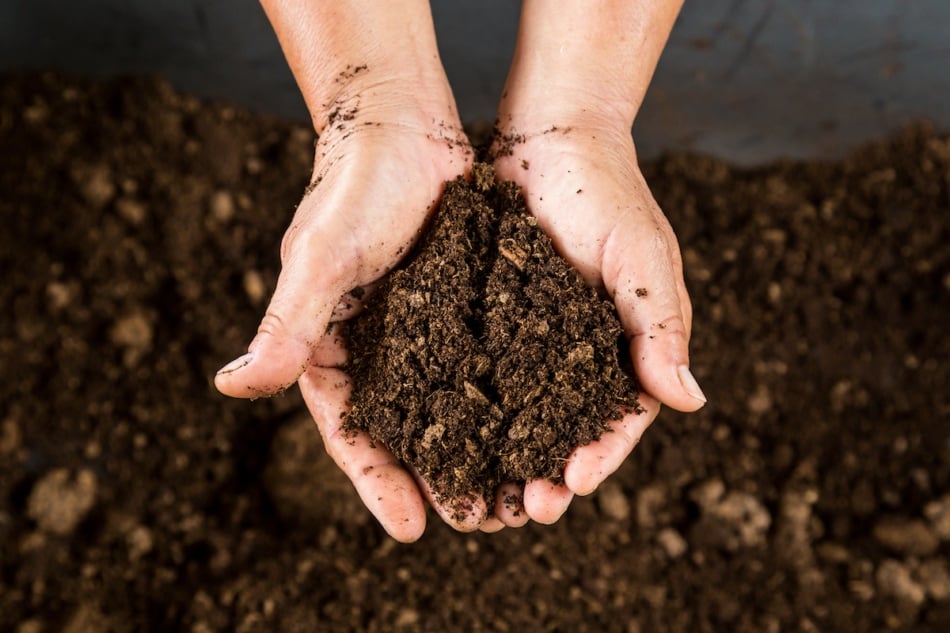7 Peat Moss Alternatives That Are Better For The Planet
Is it time to pitch the peat? If you're looking for eco-friendly alternatives to peat moss, these options are good for the garden and better for the environment.

Have you been hearing that using peat moss in your garden could be harming the environment? It might be hard to believe, since peat moss has been a staple for gardeners since the 1940s. It’s the go-to solution for many garden enthusiasts looking to improve soil texture and boost water retention and drainage. While it lacks nutrients, peat moss does offer some awesome benefits like promoting healthy bacteria and acting as a natural fungicide for your plants. However, despite its gardening perks, our planet may not be singing the same praises.
What Is Peat Moss?

Peat moss consists of various sphagnum moss species that have decomposed. Sphagnum moss is often referred to as peat moss because it is marketed and sold in this decayed state. The plant’s cell structure allows it to hold almost 20 times its dry weight in the water, making it an extremely effective material for other plants to maintain hydration.
Peat moss is used as a soil amendment for acid-loving plants, such as blueberries, and is also added to potting soils to create water retention and aeration. It is lightweight and inexpensive.
Why Is Peat Moss Bad For The Environment?

Despite its benefits in the garden, the growing and harvesting practices of peat moss have come under scrutiny as environmentally unsound practices, deeming it an unsustainable option for gardeners.
Peat moss is grown in marshy bogs and wetlands in the northern hemisphere, covering two percent of the land on earth. A majority of the world’s supply is grown in Russia, however, most of the peat moss used in the United States is harvested from the sphagnum bogs of Canada.
Peatlands store nearly a third of all the world’s soil carbon. Once harvested, the harmful carbon dioxide is released back into the environment. And while peat moss is technically renewable, the rate of growth is extremely slow, taking centuries to fully develop. It is being harvested faster than we could ever grow it, essentially making it non-renewable.
Additionally, peat bogs provide a unique ecosystem, which supports numerous insects, birds, and plants. Scientists consider peat bogs to be as fragile and important as the rainforests. Thus, exploiting this valuable flora is a valid cause for concern.
Luckily, there are better, more sustainable, and locally sourced alternatives you can use to amend your soil.
Peat Moss Alternatives
1. Coconut Coir

Coconut coir, also known as coco peat or coir peat, is rapidly gaining popularity and is the best-known alternative to peat moss. Coconut coir is made from the fibers between the shell and outer covering of coconuts. After harvesting, the long fibers of the coconut husks are used for numerous things (doormats, brushes, rope, even upholstery stuffing). However, the leftover shorter fibers can be used as a peat moss alternative. Coconut coir has excellent water-retention capabilities, holding up to 10 times its weight in water. Adding it to soil also aids in proper draining and aeration, allowing plant roots to get plenty of water and room for oxygen.
Coconut coir has an ideal 6.0 pH level, which is perfect for most garden plants, and it contains natural antifungal properties. The processing and shipping of coconut coir make it a less favorable green alternative; however, coconuts are grown and harvested for consumption already, so it is considered an eco-friendlier alternative to peat moss.
2. Wood-Based Materials

Woody materials, such as wood fiber, sawdust, or composted bark aren’t the most ideal peat moss alternative, but they do offer some benefits. Wood-based materials have been added to commercial potting mixes for decades as a way to improve water retention and add organic matter. It opens the soil for better air circulation and water movement. The pH level in wood can be low, making the soil more acidic, which is good for acid-loving plants such as rhododendrons and azaleas, but not be the best option for plants that prefer a more alkaline environment.
When choosing a wood product, it is best to use ones that are made from byproducts of untreated, locally sourced wood and not products harvested from trees specifically for horticultural uses. Wood-based materials are relatively inexpensive. Many municipalities also offer free wood chips for residents to use.
3. Compost

Compost is chock-full of beneficial microbes and nutrients and is commonly referred to as “black gold.” Made from the breakdown of yard and kitchen waste, compost is rich in microorganisms that are beneficial for the soil. “Black gold” helps with drainage, attracts beneficial earthworms, and provides nutritional value.
Compost is not a new amendment for most gardeners; however, it can also be used as an effective peat moss alternative. When added to soil, it can improve soil structure, increase water infiltration and retainment, and add beneficial microbes. Using compost helps to reduce landfill waste, while providing your soil with rich nutrients, reducing your need for chemical fertilizers.
Ever heard of trench compositing? Read about it here.
4. Pine Needles

Many homeowners are graced with a yard full of evergreens, making pine needles easy to come by. Pine needles make a readily available and renewable peat moss alternative. While pine needles can alter the texture of your soil, they do not significantly affect nutrient levels. The tannic acid in pine needles makes them acidic but does not necessarily affect the pH of the surrounding soil.
Pine needles are best used as a top dressing or mulch for plants or trees. The needles knit together, creating a mat that water can penetrate, but the wind doesn’t easily blow away. Unlike peat moss, however, pine needles do not retain water and can’t help with increasing water retention.
5. Rice Hulls

Rice hulls are the “skin” from the rice grain that is removed before rice is packaged and sold for consumption. These hulls are generally discarded, however, when preserved, they can be used as a beneficial soil additive. Thin and nearly weightless, they help lighten the soil, improve drainage and aeration, and aid in water absorption. Non-toxic and biodegradable, rice hulls feed the soil as they break down, yet they are sustainable enough to benefit your garden for an entire growing season.
Add rice hulls to your garden when you fertilize in the spring and then mix them into the top 6-12 inches of soil. Alternatively, for potted plants, you can add 10-50% rice hulls to potting soil. Rice hulls can also work like straw as a mulch to retain moisture and fend off weeds. Rice hulls also come with a neutral pH, making them an excellent organic way to balance soil.
6. Leaf Mold

Organic gardeners know the value of leaf mold. Leaf mold is simply piled-up leaves left outside, allowed to decompose or compost. It provides many advantages to gardens, making it an inexpensive, renewable, and locally sourced alternative to peat moss. When mixed with soil, leaf mold can increase the water holding capacity of soil and act as a natural soil conditioner. Creating leaf mold is similar to compost yet takes even less work—simply pile up leaves and wait for them to decompose. Be sure to turn over your leaf pile often to help accelerate the breakdown process, which can be slow.
7. Composted Manure

If you have your own livestock, or live near a farm and don’t mind the distinct aroma, composted manure is one of the best alternatives to peat moss when added to soil or used as mulch. This renewable and organic resource helps to increase soil carbon and improves beneficial microbes in your soil, improving plant growth. It also increases water holding capacity improves soil structure. When adding manure to your soil, be sure to let your manure fully compost before spreading it. Fresh manure is more acidic and has a higher concentration of nutrients, particularly nitrogen, which can be damaging to plants. You can however apply fresh manure to your garden after the fall harvest, or in the spring as it is turned over and given at least a month before seeds are planted.

Natalie LaVolpe
Natalie LaVolpe is a freelance writer and former special education teacher. She is dedicated to healthy living through body and mind. She currently resides on Long Island, New York, with her husband, children, and dog.












Test of renewable peat moss in green house
Renewable Peat moss
Best alternative for peat moss produce in our factory that passed tests and have analysis sheet.
Hi
We succeed to produce good alternative for peat moss.(recycled peat moss)
We can challenge and share it.
Hi Abbasali, Our community would love to hear more about this. Please feel free to share more!
This is voodoo science. While admittedly energy is consumed moving peat from a bog in Canada to my garden, there is no release of carbon dioxide. Per cubic foot, that peat is storing just as much CO2 in my backyard as it was in Canada. But what if some small amount was released, so what? See the trees surrounding the bog in the first picture? Without CO2, they would die. Now, sourcing a soil conditioner closer to home would be a positive for the environment, but not this carbon nonsense. We are living in an insane world where CO2, the lifeblood of every plant and tree on the planet, is officially considered a pollutant. Without CO2, there would be no life on planet earth, which may be the ultimate goal of some of the twisted minds in the environmental movement.
I love that you’re calling it bad science when you clearly don’t even have a grasp on the fundamentals of the carbon cycle. That’s something any scientist worth their salt would point out to you regardless of their opinion on the issue of climate change and how much of a role CO2 plays in it. It’s better to share no opinion than an uninformed one.
Instead of denigrating and then giving a vague rebuttal, can you please explain your response? I’m genuinely curious.
Thank you for this article. it’s very helpful. I usually use compost and well-rotted cow manure but I’ve never tried coconut coir in place of peat. I have planted perennials in coconut coir planters and placed those directly in the ground – by the next year they’ve decomposed nicely.
will spruce needles work as good as pine needles?
I,m just wondering if spruce needles are acidic as well
Hi Wesley, they should work as they are very similar to pine needles.